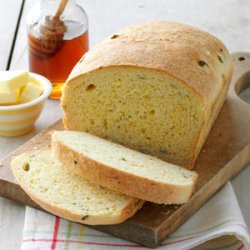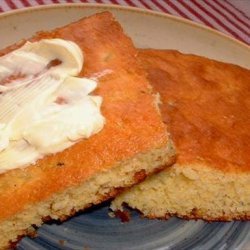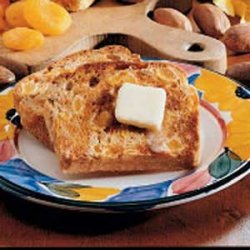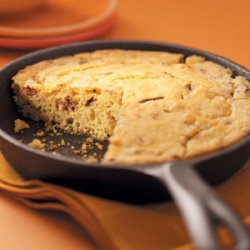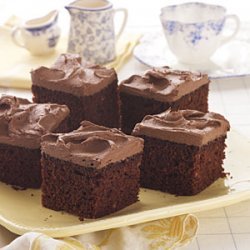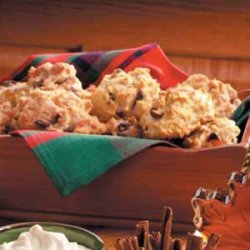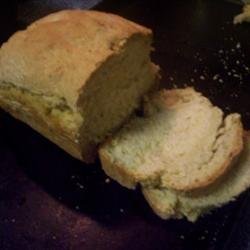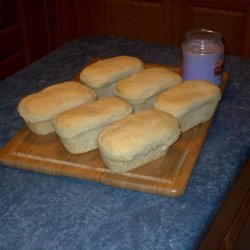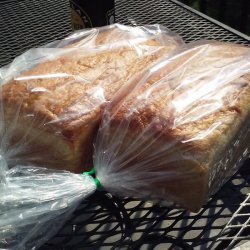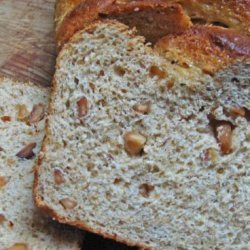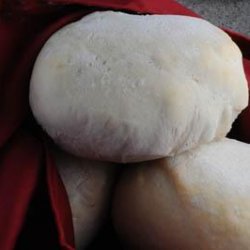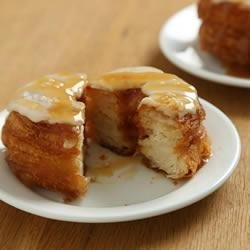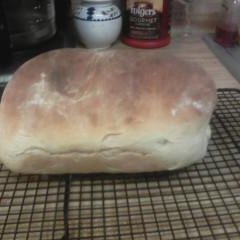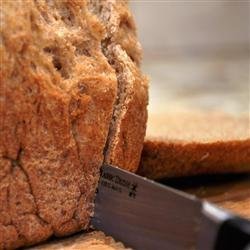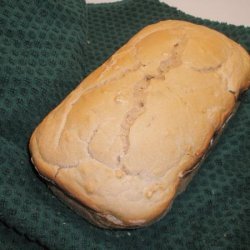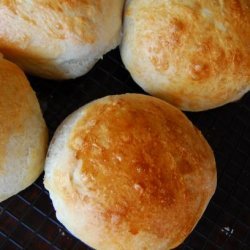Directions:
- Preparation: the evening before, in a saucepan scald the milk. In a small bowl pour the scalding hot (but not boiling) milk over the cornmeal and 1 teaspoon sugar. Stir together and cover tightly with plastic wrap. Place in a warm spot (90°-100°) where it will remain for 8 to 10 hours. A bubbly foam will develop over the surface of the cornmeal and it will smell sweet and fermented.
- By Hand: In a large mixing or mixer bowl (warmed under hot water tap), pour the hot water over the 1/2 teaspoon sugar, salt, and baking soda. Stir this briefly with a large spoon. Gradually add 1-1/2 cups flour to make a thick batter. Stir until smooth – about 50 strokes. The batter should be lukewarm to the touch. Not hot. Stir in the fermented cornmeal mixture.
- First Rising: Cover the bowl tightly with plastic wrap; return to the warm place until the batter has bubbled and foamed to more than double its volume, about 2 hours. When you turn back the plastic wrap the aroma will be quite strong.
- By Hand or Mixer: With the wooden spoon or flat beater mix in the shortening. Gradually add flour, 1/4 cup at a time, first with the spoon and then by hand. Work it well between the fingers, adding more flour, if necessary, until the dough has lost its wetness and a rough mass has formed. If using a mixer, when the dough becomes heavy remove the flat beater and replace it with the dough hook. Continue adding flour until a rough mass forms under the hook.
- Kneading: Turn the dough onto a floured work surface and begin the kneading process. This dough will feel alive under your palms, elastic and soft. The dough under the dough hook will form a soft ball around the revolving arm. Add sprinkles of flour if the dough sticks to the sides of the bowl. Knead for 10 minutes.
- By Processor: the fist 2 steps in the preparation of the dough will be done in 2 bowls, as above. Processing will come later.
- Attach the steel blade. After the batter has risen for the second time and the shortening has been added, pour the mixture into the processor work bowl. With the machine running, add flour, 1/4 cup at a time, to form a rough mass that whirls with the blade and cleans the sides of the bowl. If flour remains along the bottom edge of the bowl, scrape it free with a spatula.
- Kneading: With the processor running, knead for 60 seconds.
- Shaping: Divide the dough in half. Roll each piece into a rectangle, fold in half, pinch the seam closed, and shape the dough into a loaf. Place in the pans, seam to the bottom. The dough usually fills only half of the pan. Brush the tops lightly with oil or melted butter.
- Second Rising: Cover with wax paper and allow to rise until the dough has doubled, about 50 minutes.
- Preheat the oven to 375° about 20 minutes before baking.
- Baking: Place the pans in the oven. When the loaves are nicely browned and tapping the bottom crust yields a hard and hollow sound, about 45 minute, they are done. (If using a convection oven, reduce heat 50°.).
- Final Step: Remove the bread from the oven and turn out immediately onto a metal cooling rack.
- Toasting enhances the flavor of salt-rising bread. It may be kept frozen for several months at 0°.
- Recipe courtesy of Bernard Clayton’s New Complete Book of Breads.
Nutrition Facts
| Amount Per 1 Serving | |||
| Calories | 310.55 Kcal (1300 kJ) | ||
| Calories from fat | 94.22 Kcal | ||
| % Daily Value* | |||
| Total Fat | 10.47g | 16% | |
|---|---|---|---|
| Cholesterol | 0.15mg | 0% | |
| Sodium | 229.66mg | 10% | |
| Potassium | 80.15mg | 2% | |
| Total Carbs | 46.85g | 16% | |
| Sugars | 0.86g | 3% | |
| Dietary Fiber | 1.89g | 8% | |
| Protein | 6.24g | 12% | |
| Iron | 3mg | 17% | |
| Calcium | 21.3mg | 2% | |
| Amount Per 100 g | |||
| Calories | 285.64 Kcal (1196 kJ) | ||
| Calories from fat | 86.66 Kcal | ||
| % Daily Value* | |||
| Total Fat | 9.63g | 16% | |
|---|---|---|---|
| Cholesterol | 0.14mg | 0% | |
| Sodium | 211.24mg | 10% | |
| Potassium | 73.72mg | 2% | |
| Total Carbs | 43.09g | 16% | |
| Sugars | 0.79g | 3% | |
| Dietary Fiber | 1.74g | 8% | |
| Protein | 5.74g | 12% | |
| Iron | 2.7mg | 17% | |
| Calcium | 19.6mg | 2% | |
* Percent Daily Values are based on a 2000 calorie diet. Your daily values may be higher or lower depending on your calorie needs.
Find out how many calories should you eat.
Get Your Recipe of Health!
Follow RecipeOfHealth on Facebook!


